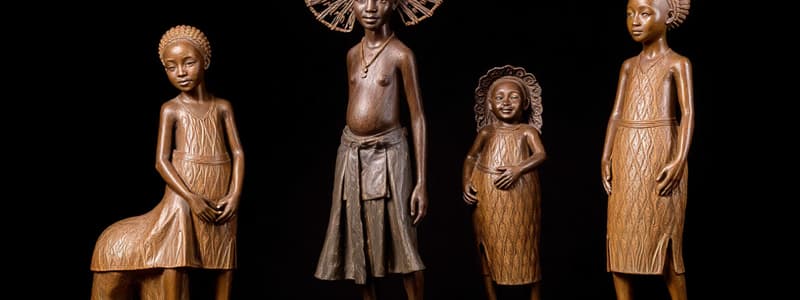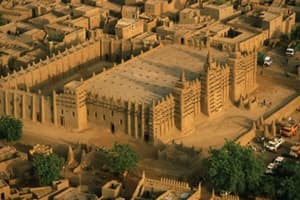Podcast
Questions and Answers
Which of the following best characterises the primary artistic output of Benin?
Which of the following best characterises the primary artistic output of Benin?
- Intricately patterned textiles and woven goods.
- Large-scale ceramic vessels and earthen structures.
- Detailed bronze sculptures and relief plaques. (correct)
- Elaborate wooden masks and ritual objects.
To which kingdom's culture is Benin Art most directly attributed?
To which kingdom's culture is Benin Art most directly attributed?
- The Ife Kingdom
- The Oyo Empire
- The Kingdom of Dahomey
- The Benin Kingdom (correct)
During which of these historical phases is Benin Art said to have achieved its peak?
During which of these historical phases is Benin Art said to have achieved its peak?
- 12th to 14th centuries
- 17th to 18th centuries
- 18th to 20th centuries
- 15th to 17th centuries (correct)
What is the predominant material used for casting the Benin sculptures?
What is the predominant material used for casting the Benin sculptures?
Which among the following best represents the narrative themes commonly depicted in Benin bronze plaques and sculptures?
Which among the following best represents the narrative themes commonly depicted in Benin bronze plaques and sculptures?
Flashcards
What is Benin Art known for?
What is Benin Art known for?
The Benin Art is primarily known for its bronze sculptures and plaques, which often depict daily life, royalty, and important historical events.
Which kingdom is associated with Benin Art?
Which kingdom is associated with Benin Art?
The Benin Art is associated with the Benin Kingdom, located in present-day Nigeria.
When did Benin Art flourish?
When did Benin Art flourish?
The Benin Art flourished between the 15th and 17th centuries, a period known for its skilled craftsmanship and artistic advancements.
What material is commonly used in Benin Art?
What material is commonly used in Benin Art?
Signup and view all the flashcards
What event led to the dispersal of Benin Art to Europe?
What event led to the dispersal of Benin Art to Europe?
Signup and view all the flashcards
Study Notes
Benin Art Study Notes
- Benin art is primarily known for its bronze sculptures and plaques.
- Benin art is associated with the Benin Kingdom.
- Benin art flourished during the 15th to 17th centuries.
- Bronze is a common material used in Benin art.
- Benin plaques and sculptures primarily depict themes of daily life and royalty.
- The Oba (King) is often featured in Benin bronze sculptures.
- The lost-wax casting technique is used in creating Benin bronze sculptures.
- The Benin Bronzes are currently housed in the British Museum.
- The British Punitive Expedition of 1897 led to the widespread dispersal of Benin art to Europe.
- Benin art is characterized by intricate details and realistic depictions.
Studying That Suits You
Use AI to generate personalized quizzes and flashcards to suit your learning preferences.



